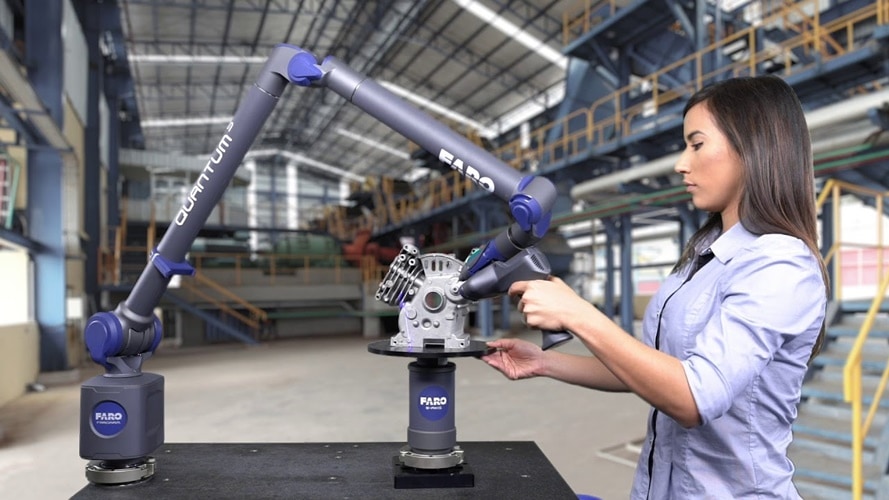Article by: Jim Cassady, Integrated Marketing Director – 3D Metrology, FARO Technologies, Inc. & MEGA Tech Magazine
หากมองจากมุมของตัวผลิตภัณฑ์ เครื่องมือวัดชิ้นงานที่ใช้กันอยู่ทั่วไปในปัจจุบัน (สร้างขึ้นจากวัสดุผสม) มีน้ำหนักเพียงแค่เศษเสี้ยวหนึ่ง ของอุปกรณ์ชนิดเดียวกันในยุคก่อนหน้า ขึ้นอยู่กับความยาวของเครื่องวัด ซึ่งโดยปกติจะอยู่ในช่วงประมาณ 1.5 – 4 เมตร เครื่องมือวัดชิ้นงานในปัจจุบันอาจมีน้ำหนักเบาที่สุดที่ 18 ปอนด์ (ประมาณ 8.164 กิโลกรัม) หรือ มีขนาด “เทอะทะ” ที่สุดที่น้ำหนัก 20 ปอนด์ (ประมาณ 9.071 กิโลกรัม) ขึ้นไป นอกจากนี้ เครื่องมือวัดชิ้นงานในปัจจุบัน ยังเป็นสิ่งที่สามารถใช้งานได้สะดวก และควบคุมทิศทางได้ง่ายมากขึ้น ด้วยการสแกนแบบโรทารี่ 8 แกน (8-axis rotary scan) อันถือเป็นความก้าวหน้าที่สามารถลดระยะเวลาในการสแกนได้มากถึง 40% ในขณะที่ยังคงรักษาไว้ซึ่งความแม่นยำเช่นเดิม

“Swinging” in to Action
ความเร็วในการสแกนได้เพิ่มมากขึ้นด้วยเช่นกัน โดยมีเหตุผลหลัก มาจากการเพิ่มสูงขึ้นของความกว้างของลำแสงเลเซอร์ที่ใช้ในการสแกน หรือ ที่เรียกกันโดยทั่วไปว่า แถบสแกนเลเซอร์ (Scan Stripe) ทำให้เครื่องมือวัดชิ้นงานในปัจจุบัน สามารถตรวจจับพื้นที่ที่มีขนาดใหญ่มากขึ้น ภายในระยะเวลาที่น้อยลง โดยที่ความละเอียดและความคมชัดไม่ได้ลดลงแต่อย่างใด และแม้แต่ประเภทของแสงเลเซอร์ที่นำมาใช้ ก็ถือว่าเป็นสิ่งที่มีพัฒนาการและมีความก้าวหน้าเพิ่มมากขึ้นเช่นเดียวกัน ในตลอดช่วงระยะเวลากว่าหลายสิบปีที่ผ่านมา สีของแสงเลเซอร์ที่มีอยู่ในปัจจุบัน ไม่ว่าจะเป็นสีแดง สีเขียว หรือสีฟ้า ก็เป็นการเพิ่มทางเลือกเพื่อให้สอดคล้องกับวัตถุประสงค์ของการใช้งานมากขึ้น
สำหรับสีเลเซอร์ทั้ง 3 สี แสงสีฝ้าจะมีความยาวของคลื่นสั้นที่สุด ด้วยเหตุนี้ มันจึงสามารถใช้ในการตรวจจับรายละเอียดที่มีขนาดเล็ก ยิบย่อย นอกจากนี้ ยังมีการพัฒนาขึ้นอย่างมากในส่วนของความสามารถของเครื่องในการสแกนพื้นผิวสีเข้ม หรือ พื้นผิวที่มีความมันวาว ด้วยค่า PAR (Point Acquisition Rate) มากกว่า 1 ล้านจุด/วินาที ก่อนที่การจะมีการพัฒนานี้ขึ้น ผู้ดูแลเครื่องจักรและช่างโลหะ จำเป็นจะต้องทาสีบริเวณดังกล่าวก่อนที่จะทำการสแกน – หรือ ต้องหันกลับไปใช้เครื่องมือช่างแบบดั้งเดิม เช่น คาลิปเปอร์ หรือ ไมโครมีเตอร์ สำหรับการวัดในลักษณะต่างๆ
เช่นเดียวกัน เลเซอร์สีเขียว ก็เป็นเลเซอร์ที่มีคุณภาพสูงกว่าเลเซอร์สีแดง ทำให้เกิดรอยด่างน้อยกว่า จึงทำให้แสดงรายละเอียดต่างๆ ได้เพิ่มมากขึ้น เลเซอร์สีเขียวยังเป็นเลเซอร์ที่ดีที่สุดสำหรับกับการให้คำจำกัดความสีที่สามารถมองเห็นได้ด้วยตา (Visual Color Definition) สำหรับการใช้งานที่ต้องการสมรรถนะการสแกนสีเต็มรูปแบบ เพื่อการตรวจจับและวิเคราะห์ข้อมูลสีที่มีความละเอียดสูงด้วยระบบคลาวด์
ถ้ามองจากมุมของซอฟท์แวร์ มันจะไม่ใช่การกล่าวเกินจริงเลย ถ้าจะบอกว่ามีความเปลี่ยนแปลง เกิดขึ้นอย่างมากมายมหาศาล หลังจากที่ Homer Eaton ผู้ซึ่งถือได้ว่า เป็นบิดาของเครื่องมือวัดชิ้นงานชนิดความแม่นยำสูงสมัยใหม่ ได้จดสิทธิบัตรเครื่องเวคเตอร์ 1 ของเขา สิ่งที่ไม่มีให้เห็นอีกต่อไปแล้วคือ เครื่องคอมพิวเตอร์ขนาดมโหฬาร และเครื่องที่มีลักษณะเหมือนโทรพิมพ์ (teletype-like) ซอฟท์แวร์ในปัจจุบันได้ถูกออกแบบมาสำหรับใช้งานกับคอมพิวเตอร์ทั้งแบบตั้งโต๊ะ และแบบพกพา และสามารถใช้งานได้ทั้งกับระบบ IT แบบตั้งอยู่ที่ไซต์งาน (On-Premise) และแบบ ที่อยู่บน Server/ฐานข้อมูลบนคลาวด์ (On-Cloud) ด้วยกราฟฟิกบน User Interfaces และชุดข้อมูลคำสั่งแบบ Intuitive Commands ผู้ใช้งานเกือบทุกราย ไม่ว่าจะมีประสบการณ์หรือความชำนาญทางเทคนิคมากน้อยเพียงใด ล้วนสามารถที่จะฝึกฝนและสร้างความชำนาญการใช้งานโปรแกรมต่างๆ เหล่านี้
หลังจากที่มีการนำข้อมูลเข้าสู่ซอฟท์แวร์ ภาพสแกน 3 มิติ (มาตรฐานเครื่องมือวัดตามเกณฑ์มาตรวัดวิทยา) จะถูกสร้างขึ้น พร้อมๆ กับข้อมูลที่เกี่ยวข้องกับภาพสแกนดังกล่าว ซึ่งผู้ใช้งานสามารถส่งต่อไปยังหน่วยอื่นๆ ภายในองค์กรได้ทันทีแบบ real time ทั้งในรูปแบบของข้อมูลดิบ กราฟ และรายงานแสดงผลแบบมีภาพประกอบ (Visual Report)
ประโยชน์ของซอฟท์แวร์ในลักษณะดังกล่าวมีอยู่อย่างชัดเจน: ข้อมูลเชิงลึกแบบหาตัวจับยากเกี่ยวกับความผันแปรในกระบวนการผลิต การแจ้งเตือนที่จะช่วยให้ผู้ใช้งานสามารถหลีกเลี่ยงการแก้ไขหรือปรับปรุงชิ้นงานใหม่ หรือ ทำซ้ำอีกครั้ง (rework) ซึ่งเป็นสิ่งที่ต้องใช้เวลานาน และทำให้เกิดจ่ายเพิ่มเติมที่ค่อนข้างสูง นี่จึงเป็นโอกาสดีสำหรับบริษัทต่างๆ ในการพัฒนาเพื่อเพิ่มประสิทธิภาพในกระบวนการผลิต

The “Reach to Succeed”
เช่นเดียวกับการที่เราได้เดินทางมาไกลมาก จากเครื่องมือวัดชิ้นงานยุคแรกในช่วงกลางของทศวรรษ 1970 (ประมาณช่วง พ.ศ. 2517) เทคโนโลยีนี้จะยังคงมีการพัฒนาและก้าวหน้าต่อไป รวมถึงผลิตภัณฑ์ต่างๆ ที่เกี่ยวข้อง ก้านวัดที่มีน้ำหนักเบายิ่งกว่านี้จะได้รับการพัฒนาขึ้น ระยะเวลาของการสแกนจะยังคงลดลงอย่างต่อเนื่อง และผู้พัฒนาซอฟท์แวร์จะยังคงเพียรพยายามสร้างความก้าวหน้าและขยายขอบเขตของเทคโนโลยีโลกเสมือน (augmented reality) และเครื่องยนต์ปัญญาประดิษฐ์(artificial intelligent machines) ต่อไป
ในหนังสือ “Profiles of the Future: An Inquiry into the Limits of the Possible” ซึ่งได้รับการตีพิมพ์เมื่อปี ค.ศ. 1962 (พ.ศ.2505) นักเขียนนวนิยายทางวิทยาศาสตร์และนักอนาคต (Futurist) ชื่อดังอย่าง Arthur C. Clarke ได้ให้ข้อสังเกตที่ได้กลายมาเป็นที่รู้จักอย่างกว้างขวางในปัจจุบันว่า “เทคโนโลยีขั้นสูงอย่างแท้จริงเป็นสิ่งที่ไม่อาจแยกออกจากเวทมนตร์” (Any sufficiently advanced technology is indistinguishable from magic)
ในโลกของเทคโนโลยีเครื่องมือวัดชิ้นงานความแม่นยำสูง มันจึงเป็นเรื่องที่น่าตื่นตาตื่นใจอย่างยิ่งที่จะเฝ้ารอดูวันที่ “ช่วงเวลาแห่งเวทมนตร์” นั้น จะมาถึง
Ref : www.sumipol.com












